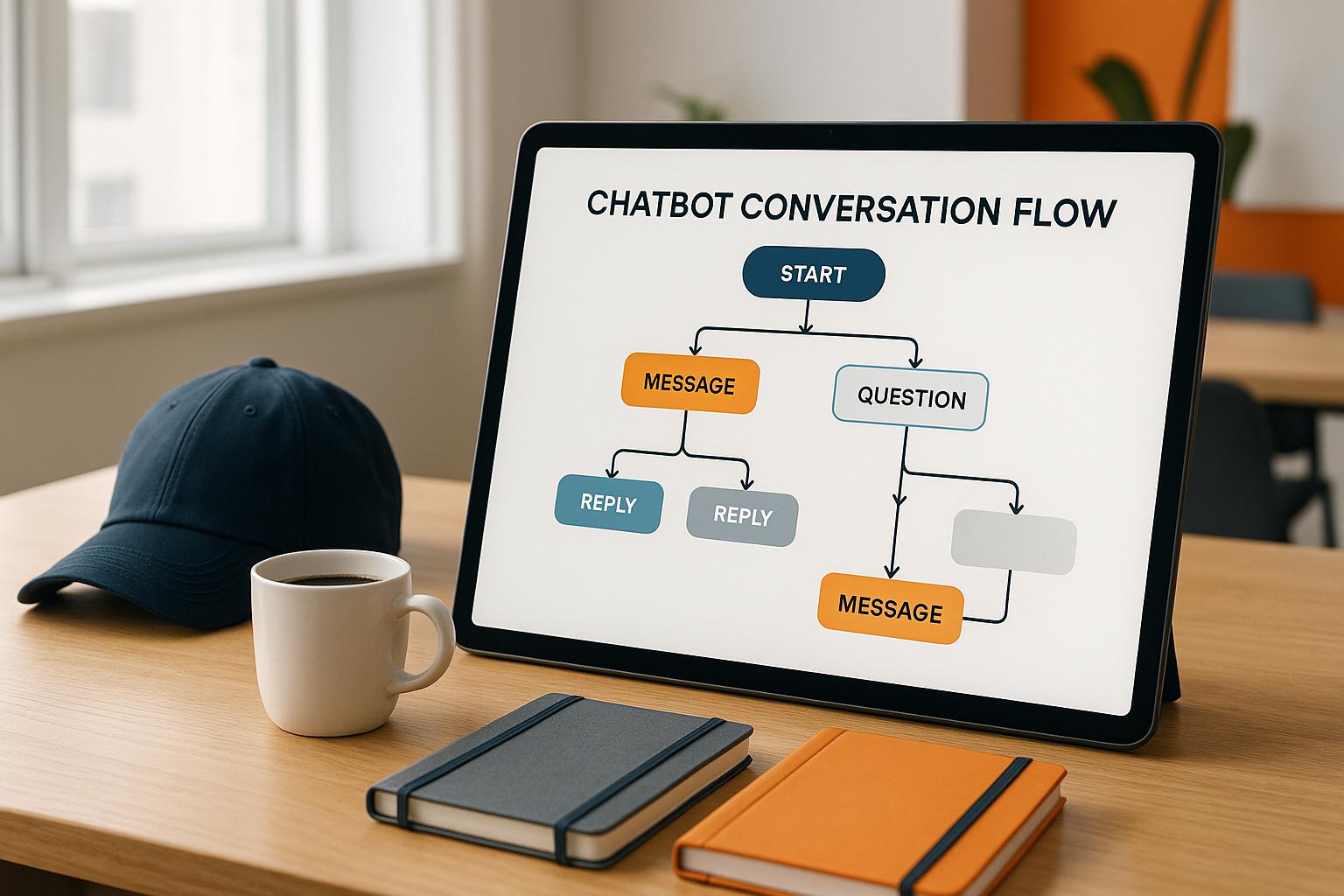AI is changing how brands connect with audiences. It helps marketers create stories tailored to individual preferences using data, making campaigns more engaging and personalized. Here are five key techniques brands are using to stand out:
- Data Analysis for Audience Insights: AI examines customer behavior, feedback, and trends to craft stories that resonate. For example, brands using AI have seen up to 30% higher engagement rates.
- Generative AI for Personalized Content: Tools like ChatGPT and Jasper produce custom narratives at scale, ensuring messages align with audience needs.
- AI-Generated Visuals and Multimedia: Platforms like DALL-E and Synthesia create custom images and videos, enhancing storytelling across platforms.
- Real-Time Content Adjustments: AI tools monitor user interactions and adapt stories instantly, improving relevance and performance.
- Human-AI Collaboration: AI provides data-driven insights, while human input ensures stories remain relatable and trustworthy.
These techniques are helping marketers improve efficiency, scale campaigns, and connect with U.S. audiences in meaningful ways.
Strategies for AI-Driven Storytelling in Marketing
1. Data-Driven Audience Insights
AI is transforming how marketers understand their audiences by analyzing massive amounts of customer data. This data – gathered from social media interactions, website activity, purchase history, and feedback – reveals patterns that help brands create stories that deeply connect with their target audiences. This approach lays the groundwork for more advanced AI techniques that refine brand storytelling even further.
Effectiveness in Improving Brand Storytelling
With data-driven insights, marketers can move beyond guesswork. By analyzing text, images, and videos, AI uncovers trends – like how American consumers often respond to stories highlighting innovation and community. This targeted storytelling approach has shown impressive results, including up to 30% higher engagement rates and similar improvements in campaign ROI. Additionally, AI’s ability to predict future behaviors and interests allows marketers to adjust their strategies proactively, ensuring their content remains impactful and relevant.
Alignment with U.S. Audience Preferences
AI excels at capturing the subtleties of American consumer preferences. By segmenting audiences based on region, age, and background, brands can tailor their stories to resonate more effectively. For example, one eCommerce brand used AI to analyze customer feedback and social media sentiment, finding that sustainability was a key concern for U.S. consumers. The brand then launched a campaign showcasing its eco-friendly practices, with AI-generated visuals and narratives customized for different regions. The result? Increased engagement and a noticeable boost in brand loyalty. AI tools process a wide range of data – like demographics, behavior, and real-time interactions – to uncover actionable insights such as trending topics or preferred content formats, helping brands stay relevant.
Scalability for Diverse Marketing Campaigns
AI makes it easier for brands to scale personalized storytelling across multiple campaigns and platforms. By automating data analysis and content creation, marketers can produce hundreds of story variations tailored to specific U.S. audience segments without overburdening their creative teams. This scalability is especially valuable, as AI-driven personalization has been shown to boost engagement rates by up to 40% compared to generic content. Whether it’s localized email campaigns reflecting state-specific events or tailored social media posts for different demographic groups, AI ensures the messaging remains relevant while maintaining brand consistency.
Ability to Maintain Brand Trust
In today’s privacy-conscious world, accurate and transparent use of data is key to maintaining consumer trust. By relying on up-to-date, precise data, brands can keep their messaging relevant and consistent, building credibility with U.S. audiences. AI also monitors audience feedback in real time, allowing brands to address concerns or fine-tune their messages quickly. To ensure ethical and effective storytelling, brands should conduct regular data audits, communicate clearly about data usage, and involve cross-functional teams to review AI-driven narratives. Combining AI’s analytical strengths with human creativity and ethical oversight ensures that brand stories remain both impactful and trustworthy. These practices set the stage for the adaptive, multimedia-driven strategies discussed in upcoming sections.
For more tips on integrating audience insights into your storytelling, check out expert advice at JeffLizik.com.
2. Generative AI for Personalized Narratives
Generative AI is transforming storytelling by using data-driven insights to craft personalized narratives at scale. Tools like ChatGPT, Jasper, and Gemini are reshaping how brands connect with audiences, turning customer data into tailored stories that reflect a brand’s voice. These platforms analyze customer behavior and feedback to create content that adapts tone and style for specific audience segments, paving the way for more impactful storytelling.
Effectiveness in Improving Brand Storytelling
Generative AI’s strength lies in its ability to produce personalized content at scale. Unlike traditional methods that rely on broad demographic assumptions, AI digs deep into data from social media, reviews, and forums to uncover what truly resonates with audiences. This allows brands to move beyond generic messaging and craft narratives that feel uniquely relevant to their customers.
Recent statistics show that 73% of U.S. marketers now incorporate generative AI into their strategies, underscoring its growing role in brand storytelling. AI’s ability to adjust complexity, tone, and even cultural references ensures content aligns with both a brand’s identity and its audience’s expectations. The result? Higher engagement rates compared to mass-produced, one-size-fits-all content.
One marketing agency described their experience with an AI copy generator as a "game-changer" when it perfectly captured their brand’s voice for the first time. This highlights how far AI has come – from producing robotic-sounding text to delivering authentic, relatable narratives that feel human.
Alignment with U.S. Audience Preferences
Generative AI is particularly adept at creating content that resonates with American consumers. By training the technology on U.S.-specific data, brands can ensure their messaging reflects American cultural nuances. This includes using proper spelling conventions (like "color" instead of "colour"), adopting American date and currency formats, and referencing holidays or events that strike a chord with domestic audiences.
But it goes beyond surface-level adjustments. AI can analyze regional language patterns, preferences, and values to craft stories that feel familiar and trustworthy. For example, U.S. audiences often respond well to themes like innovation, community involvement, and individual achievement. Generative AI can seamlessly weave these elements into brand narratives, even adapting messaging for regional differences across the country.
Scalability for Diverse Marketing Campaigns
Generative AI shines in its ability to scale storytelling through content atomization – breaking down content into modular pieces that can be reassembled for various platforms and campaigns.
"Content atomization – modular content pieces assembled for diverse channels" – Jeff Lizik, Founder, RedShift Digital Marketing Agency
This modular approach allows brands to produce countless variations of a story tailored to different audience segments, all without overloading creative teams. AI can fine-tune messaging for specific platforms, such as condensing text for Twitter, expanding it for blogs, or creating visually engaging versions for Instagram. It even supports real-time content adaptation, adjusting narratives based on user interactions and feedback to create dynamic, evolving content experiences.
Ability to Maintain Brand Trust
While generative AI offers incredible opportunities, preserving authenticity is crucial. The key is to define your brand values and objectives clearly before integrating AI into your content process. These guidelines should be embedded in AI prompts to ensure consistent, authentic messaging.
Human oversight remains essential. Marketers must review AI-generated content to ensure it aligns with brand goals, ethics, and the human touch. Regular reviews can catch issues with tone, accuracy, or unintended messaging. Additionally, being transparent about the use of AI can strengthen trust with American consumers.
Pairing generative AI with visual tools like DALL-E and Midjourney takes this a step further, creating cohesive brand experiences where written narratives align perfectly with custom visuals. This unified approach ensures every interaction reinforces the brand’s story while maintaining the authenticity that consumers expect.
3. AI-Powered Visual and Multimedia Content Generation
Visual storytelling has come a long way from static images and basic videos. Today, AI-powered tools create interactive, dynamic content experiences that adapt to user behavior, reshaping how brands engage with their audiences through multimedia storytelling.
Platforms like DALL-E 2 and Midjourney allow users to generate custom images from text prompts, while tools like Synthesia make it possible to create video content without traditional filming. These technologies use machine learning to turn data and prompts into narrative-driven assets such as images, videos, and graphics. But they don’t stop at creation – AI can analyze emotional responses and emerging trends to predict which visuals will resonate most with specific audience segments, amplifying the overall impact of a brand’s story. This advancement is redefining how brands craft and measure the success of their visual narratives.
Effectiveness in Improving Brand Storytelling
AI-powered tools are helping brands create engaging, personalized narratives that connect with customers in ways traditional methods often couldn’t. Before generative AI, brands faced challenges like limited resources and slow data analysis, making it difficult to produce tailored visual content that truly resonated.
Now, AI enables brands to craft hyper-personalized narratives by analyzing audience-specific data. This allows them to address individual preferences and emotional triggers, fostering deeper connections and building trust. AI leverages image recognition and emotional analysis to select visuals that enhance stories and evoke the desired response from viewers. By streamlining marketing workflows and tailoring content to individual needs, brands can move beyond broad demographic assumptions and deliver stories that feel personal and impactful.
AI also ensures that visuals align seamlessly with the narrative’s tone and message. It organizes content flow to create a cohesive blend of compelling text and supporting visuals, ensuring the story resonates with its intended audience.
Alignment with U.S. Audience Preferences
AI’s ability to process vast amounts of data from U.S. customer interactions, market trends, and social media activity allows brands to fine-tune their visual content to suit American preferences. By analyzing images and videos, AI identifies the types of visuals that resonate most with U.S. audiences, ensuring the content strikes the right emotional chord.
73% of U.S. marketers are already incorporating generative AI into their strategies, reflecting its growing importance in the American market. AI can even predict future consumer interests and behaviors, enabling brands to deliver personalized visuals, messages, and recommendations that resonate deeply with their audience.
Additionally, AI can recognize logos and brand elements in user-generated content, helping brands identify organic ambassadors. This insight allows companies to tap into authentic, user-driven storytelling, which is particularly effective in connecting with American consumers.
Scalability for Diverse Marketing Campaigns
AI has made it easier than ever to scale visual and multimedia content for a variety of marketing campaigns. By automating the creation of personalized stories, brands can now achieve levels of customization that were previously impossible without exhausting creative resources.
"Content atomization – creating modular, reusable content pieces that can be assembled differently for different channels and needs" – Jeff Lizik, Founder, RedShift Digital Marketing Agency
This content atomization strategy enables brands to create modular visual elements that can be repurposed across platforms and campaigns. AI processes massive datasets to generate highly personalized visual stories at scale, ensuring that brand messages remain consistent and impactful across all customer touchpoints.
AI also integrates seamlessly with marketing technology stacks, optimizing the storytelling process. From static images to dynamic videos, voiceovers, and even music, the possibilities for creative storytelling expand significantly with AI. This scalability supports a collaborative human-AI approach, ensuring that brand authenticity remains intact.
Ability to Maintain Brand Trust
Even with all its capabilities, human oversight is essential to ensure AI-generated visuals align with a brand’s values and ethical standards. While AI provides efficiency and data-driven insights, human involvement ensures that the final product resonates with the brand’s identity and messaging. This collaboration guarantees that the visuals are not only engaging but also trustworthy.
The partnership between AI and humans combines the best of both worlds – AI’s ability to analyze data and predict trends with human creativity and ethical judgment. By incorporating brand values into AI prompts, brands can ensure their stories reflect their identity and meet marketing objectives. This blend of technology and human expertise results in visual narratives that are both emotionally compelling and aligned with the brand’s mission.
AI also assists in distributing visual content across the right channels and monitors audience engagement. By analyzing feedback, brands can refine their storytelling efforts over time, making each campaign more effective than the last. This iterative process ensures that AI-generated visuals not only maintain brand trust but also continue to forge meaningful connections with audiences.
sbb-itb-d6d4d8b
4. Real-Time Content Adaptation and Performance Analysis
Static campaigns are a thing of the past. Thanks to advancements in dynamic content creation, AI now allows brands to refine their messaging in real time. Modern AI tools monitor audience interactions with brand stories and adjust content instantly to boost engagement and impact. This shift from static to dynamic content creates an evolving experience shaped by live audience feedback.
Platforms like Adobe Target, Twilio Segment, and generative AI tools like ChatGPT and Jasper analyze user data continuously. They automate A/B testing and provide actionable insights to fine-tune storytelling. These systems track key metrics – click-through rates, social shares, comments, and time spent engaging – and use that data to optimize messaging, visuals, and calls-to-action. The result? A brand message that evolves in real time, always staying relevant.
Boosting Brand Storytelling Effectiveness
Real-time adaptation keeps brand stories fresh and engaging by responding directly to audience behavior. This approach not only increases engagement but also creates more memorable experiences.
Take the example of Magnet Media Films, which worked with a major U.S. retailer in February 2024. Using AI-powered real-time content adaptation, the retailer saw a 30% jump in campaign conversion rates. The AI system adjusted messaging and visuals on the fly based on live interactions, leading to a $1.8 million boost in revenue and a 22% rise in customer engagement.
These adaptations rely on a mix of data, including engagement metrics like clicks and shares, demographic and location information, and sentiment analysis from social media and customer reviews. AI also taps into browsing habits and purchase history to personalize content for different audience segments.
Tailoring Content for U.S. Audiences
AI doesn’t just refine content; it ensures it resonates with U.S. audiences by aligning with their preferences and cultural nuances. By analyzing massive datasets from U.S. social media, website interactions, and customer feedback, AI identifies trends and preferred content formats. This allows brands to craft stories that reflect American values and interests, whether it’s using the dollar sign ($), U.S. date formats, or other local references.
For instance, if data shows that U.S. audiences prefer short-form videos over static images, AI can shift the campaign’s focus accordingly. This often leads to better social shares and increased online sales. Additionally, AI can predict emerging consumer trends, giving brands an edge in the fast-paced U.S. market.
Scaling Across Multiple Campaigns
AI makes it possible to adapt content across numerous channels – social media, email, and websites – by automating optimizations based on each platform’s performance data. This scalability allows brands to maintain consistent messaging while tailoring content to different audience segments, regardless of the campaign’s size or complexity.
Through a process called content atomization, AI breaks down content into modular pieces and reassembles them based on live performance data. This ensures the best combinations of messaging and visuals for various platforms and audiences. Brands that use AI for real-time adaptation often report up to 30% higher conversion rates compared to static campaigns.
AI systems can also integrate with existing marketing technology stacks, creating seamless data flows that enable marketers to scale efforts without adding extra workload. Personalization driven by AI has been shown to boost engagement rates by as much as 74% compared to generic content.
Balancing Automation with Brand Trust
While AI excels at automating optimizations, human oversight is crucial to maintaining a brand’s authenticity. The most effective strategies combine AI’s efficiency with human creativity, ensuring that brand stories remain true to their core values. Over-reliance on automation risks creating generic or inauthentic narratives, which could erode trust.
To strike this balance, brands should set clear objectives and KPIs, ensure compliance with U.S. data protection laws, and regularly review AI-generated insights. Training teams on AI capabilities and ethical considerations is also essential for proper oversight.
JeffLizik.com provides AI-driven marketing solutions that help U.S. brands craft effective strategies, monitor campaigns in real time, and adapt content based on live audience feedback. Through consulting services and an AI-powered newsletter, the platform offers personalized recommendations and industry insights, helping brands optimize their storytelling while preserving authenticity and trust.
5. Human-AI Collaboration for Trust Building
When human creativity meets AI-driven insights, brands can craft stories that truly resonate. AI excels at analyzing customer behavior and scaling personalized content, while human input brings emotional intelligence and cultural understanding into the mix. Together, this collaboration creates narratives that are both data-informed and meaningful to American audiences.
Enhancing Brand Storytelling
The combination of human creativity and AI precision is transforming how brands tell their stories. AI can sift through massive amounts of customer data, identifying trends and engagement patterns that might otherwise go unnoticed. Using techniques like machine learning and natural language processing, AI uncovers insights about U.S. consumer behavior and preferences. It can even generate initial frameworks for narratives. But the real magic happens when human marketers step in to refine these frameworks, ensuring they align with brand values and connect with local audiences.
Marketers act as interpreters, taking AI-generated insights and turning them into authentic, engaging stories. For example, brands like Coca-Cola and Nike have successfully used this approach. While AI helps them understand what resonates, human oversight ensures the final message stays true to their core values and avoids the generic tone that can come from relying solely on automation.
Connecting with U.S. Audiences
American consumers tend to value authenticity, straightforward communication, and personalization in brand messaging. Human-AI collaboration delivers on these expectations by blending data analysis with cultural awareness. While AI can identify trends and preferences, human marketers bring the insights to life by crafting messages that feel genuine and relatable.
For instance, if AI reveals that U.S. audiences respond better to stories featuring real customer experiences rather than celebrity endorsements, marketers can adjust their strategy to prioritize user-generated content and testimonials. This approach not only enhances authenticity but also reflects values like innovation and diversity that resonate with American audiences.
Additionally, human oversight ensures cultural sensitivity. While AI can flag potential issues, it’s the human touch that prevents missteps and maintains the integrity that American consumers expect from trusted brands.
Scaling Campaigns Without Losing Consistency
Human-AI collaboration also makes it possible to scale marketing efforts across multiple platforms without compromising quality. AI handles repetitive tasks like breaking down stories into adaptable pieces for different channels, while human marketers ensure the core message stays intact and fits the unique demands of each platform.
AI tools can also track real-time performance across social media, email, websites, and more, allowing teams to make quick adjustments. This balance between automation and human input ensures campaigns remain consistent and effective while retaining the personal touch that builds trust.
Keeping Brand Trust Intact
Trust is at the heart of any successful brand story, and human involvement plays a critical role in maintaining it. While AI can generate content and analyze metrics efficiently, human marketers review the output to ensure it aligns with brand values and ethical standards. This is especially important when dealing with sensitive or complex topics.
Transparent collaboration between humans and AI strengthens trust among U.S. consumers. By continuously monitoring and refining strategies, brands can ensure their stories stay relevant and reliable as consumer preferences shift over time.
Platforms like JeffLizik.com support this collaboration by offering AI-driven marketing systems and consulting services. Their personalized approach helps marketing teams build scalable, authentic storytelling strategies that connect with U.S. audiences and foster long-term trust.
Conclusion
These five AI techniques are reshaping how brands connect with American audiences by blending data-driven insights, personalized storytelling, dynamic visuals, real-time adjustments, and human-AI collaboration.
A recent study highlights that 73% of U.S. marketers are now using generative AI, and 51% rely on AI for storytelling purposes. This growing adoption underscores the real advantages of pairing AI’s capabilities with human creativity.
AI excels at processing massive amounts of data to reveal insights about American consumer behavior and emerging trends. This data-driven groundwork allows marketers to focus on what they do best – infusing campaigns with emotional intelligence, cultural sensitivity, and a consistent brand voice. While AI manages tasks like data analysis, content creation, and performance monitoring, human oversight ensures authenticity and a relatable tone.
To make these strategies work, brands need to clearly define their values and objectives. AI can be used to analyze audiences and craft personalized content, but human involvement is essential to maintain a genuine connection and avoid the pitfalls of over-automation.
Effectiveness should be tracked through metrics like engagement rates, sentiment analysis, and customer loyalty indicators. These tools not only provide actionable insights for refining campaigns but also highlight the value of combining AI’s efficiency with human ingenuity.
As the marketing landscape continues to evolve, brands that successfully integrate human-AI collaboration will strengthen their bonds with audiences. With adoption rates climbing and results becoming increasingly clear, the question isn’t whether to implement these techniques – it’s how soon brands can adapt to stay competitive in the U.S. market.
JeffLizik.com offers AI-powered marketing solutions and expert guidance to help teams navigate this evolving space. Their consulting services ensure campaigns remain forward-thinking and effective while preserving the human touch that fosters trust and loyalty.
FAQs
How can AI help brands connect with U.S. audiences through more effective storytelling?
AI has become a powerful tool for brands looking to better understand and connect with U.S. audiences. By processing massive amounts of data, it can reveal key preferences, behaviors, and emerging trends that shape how people engage with content and products. This gives marketers the opportunity to create stories that genuinely resonate with their audience.
For instance, AI can sift through customer feedback, track social media interactions, and study purchasing behaviors to uncover what truly matters to U.S. consumers. Armed with this knowledge, brands can craft personalized and compelling narratives that reflect the values and interests of their audience. On top of that, AI can assist in testing and refining these storytelling approaches, making sure they hit the mark and achieve the intended results.
How does human creativity enhance AI-generated brand stories?
Human ingenuity is key to shaping and improving AI-generated brand stories. While AI excels at crunching data and coming up with content ideas, it often falls short when it comes to emotional depth and the subtle nuances that make storytelling truly powerful. When marketers pair AI’s strengths with human insight, they can craft narratives that connect on a deeper level with their audience.
Humans bring something special to the table – personal perspectives, emotional relatability, and context that aligns with cultural norms. These elements make AI-driven content feel more personal and engaging. The result? Brand stories that aren’t just guided by data but leave a lasting impression on the audience.
How can brands make sure their AI-generated content feels authentic and trustworthy to U.S. audiences?
To make AI-generated content feel genuine and reliable, brands should emphasize contextual relevance and use natural language patterns. Instead of chasing isolated keywords, aim to produce content that fits seamlessly into the larger framework of the topic. AI tools can be incredibly helpful here, optimizing for semantic context to create material that connects more naturally with readers.
On top of that, consider creating interactive and dynamic content that responds to user behavior. This strategy not only boosts engagement but also strengthens trust by offering personalized and meaningful experiences. Always take the time to review AI-generated content to ensure it reflects your brand’s voice and values.








